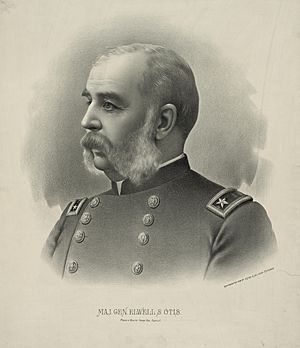Elwell Stephen Otis facts for kids
Quick facts for kids
Elwell S. Otis
|
|
|---|---|
 |
|
| 2nd American Military Governor of the Philippines | |
| In office August 28, 1898 – May 5, 1900 |
|
| Preceded by | Wesley Merritt |
| Succeeded by | Arthur MacArthur Jr. |
| Member of the Schurman Commission | |
| In office March 4, 1899 – March 16, 1900 |
|
| Preceded by | Newly created |
| Succeeded by | Bernard Moses (Taft Commission) |
| Personal details | |
| Born | March 25, 1838 Frederick, Maryland, U.S. |
| Died | October 21, 1909 (aged 71) Rochester, New York, U.S. |
| Spouses |
|
| Alma mater |
|
| Military service | |
| Allegiance |
|
| Branch/service | |
| Years of service | 1862–1902 |
| Rank | |
| Unit | |
| Commands | 20th Infantry Regiment Eighth Army Corps |
| Battles/wars | American Civil War
Spanish–American War Philippine–American War
|
Elwell Stephen Otis (born March 25, 1838 – died October 21, 1909) was an important United States Army general. He served in several major conflicts. These included the American Civil War, the Indian Wars, and later the Philippine–American War. He played a key role in the Philippines during a time of big changes.
Contents
Elwell S. Otis: A Life Story
Elwell S. Otis was born in Frederick, Maryland, on March 25, 1838. He went to the University of Rochester. Later, he studied law at Harvard Law School and became a lawyer. He was working as a lawyer when the American Civil War began.
Serving in the Civil War
During the American Civil War, Otis joined the army. He became a captain in the 140th New York Volunteer Infantry Regiment in September 1862. He fought in famous battles like Fredericksburg, Chancellorsville, and Gettysburg.
He was promoted to lieutenant colonel in December 1863. At the Battle of Spotsylvania, he took command of his regiment. He fought in many battles during the Overland Campaign. Later, during the Siege of Petersburg, he was badly wounded. This injury ended his time fighting on the front lines in the Civil War. He was recognized for his bravery and promoted to brevet brigadier general. After recovering, he continued his army career.
Serving in the Indian Wars
After the Civil War, Otis stayed in the army. He served in the Indian Wars, including campaigns in Montana. This was after the Battle of the Little Bighorn. In 1880, he became a colonel. By 1893, he was a brigadier general in the regular army. He commanded different army departments across the United States.
Role in the Philippine-American War
In May 1898, Otis was made a major general of volunteers. He was sent to the Philippines with more troops. There, he took command of the Eighth Army Corps. He replaced General Wesley Merritt as the military governor of the Philippines in August 1898.
Otis led the U.S. Army during the Philippine–American War. He was in charge during the Battle of Manila (1899) in 1899. This was during the first part of the war, before it became more of a guerrilla fight. When Emilio Aguinaldo tried to stop the fighting, General Otis said that the war, once started, had to continue to the end.
During this time, there were also challenges and difficult situations. Reports mentioned that some soldiers acted harshly. General Otis looked into these reports.
Later Years and Legacy
General Otis was replaced in the Philippines in 1900 by Arthur MacArthur Jr.. He returned to the United States and continued to command army departments. He was appointed major general in the regular army in 1906.
Otis was known as a skilled general and a good administrator. However, some of his soldiers and fellow officers found him difficult to work with. The newspapers sometimes criticized him. His troops even called him "Granny" because of his age and gray hair. He died in Rochester, New York, in 1909 from a heart condition.
His Family Life
Elwell S. Otis was married two times. His first wife was Louise Selden. They married in 1870 and had two daughters:
- Laura Lu Otis, born in 1872. She married Harry K. Elston.
- Mary L. Otis, born in 1875. She married Ralph Isham.
His second wife was Louisa Bowman. They married in 1878 and had one child:
- Louise B. Otis, born in 1882. She married George Wagner.
Louisa "Lulu" Otis, Elwell Otis's widow, passed away in Santa Barbara, California, in 1934.
Remembering Elwell S. Otis
For many years, June 15 was celebrated as Otis Day in Rochester, New York. This celebration no longer takes place.
Elwell S. Otis in Movies
- He was played by E.A. Rocha in the Philippine film, Heneral Luna (2015).
- He was also in the sequel, Goyo: Ang Batang Heneral (2018).
See also
 In Spanish: Elwell S. Otis para niños
In Spanish: Elwell S. Otis para niños

